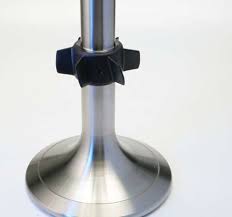Valve Rotator: Each time a valve opens, the valve rotator turns the valve slightly. This prevents the valves from sticking due to carbon build-up. Additionally, it allows the inlet and exhaust valves to be heated and cooled symmetrically.
TYPES OF VALVE ROTATOR
There are two types of valve rotators
1.non- positive type or release type
2. positive type
NON-POSITIVE TYPE
Non-positive type rotators release the spring tension from the valve while open. this allows the valve to rotate from engine vibration
There are two types of non-positive valve rotators
1. Split-collet valve rotators
2. Thimble valve rotators
SPLIT-COLLET VALVE ROTATORS
The stem of the valve has three annular grooves of a semi-circular section and the inner surface of each collet has three semicircular ribs. These press against each other providing a small radial clearance between the valve and the collects. The vibration of the valve gear rotates the valve at between 15 and 25 rpm at engine speeds above 1500 rpm.
THIMBLE VALVE-ROTATOR.
In the thimble rotator design, a steel cap fits over the end of the valve stem and rests on two semicircular collets which fit in the valve-stem groove below. The valve spring maintains pressure on the retainer against these collets and so keeps the valve closed. When the valve is required to be opened, the rocker-arm presses down the cap which in turn bears against the two collets, and then moves the valve spring and retainer downwards. The spring pressure is now taken by the cap, and hence the valve is freed from spring pressure. It is still moved downwards because the closed end of the cap then abuts the valve-stem end, but it is free to turn.
POSITIVE TYPE VALVE-ROTATORS ALSO KNOWN AS ROTOCAP
This incorporates a ball-retaining plate with ramped grooves for balls to roll along. A small spring pushes each of these balls to one side. A Belleville-type dished spring washer fits over these balls to form an upper race, which is supported on its outer edge by a retainer. This retainer holds the whole assembly together and also provides a seat for the helical coil springs
There is a collet or cotter which is on the valve cover fitted around the exhaust valve. The valve cover has several inclined tracks machined into it. Each contains a ball and a spring. The ball runs on the race. When the valve is closed, the Belville washer pushes the ball and locks them halfway in the inclined track which creates compression on the spring.
When the valve starts to open, the increased valve spring force causes the Belville washer to flatten. The ball race no longer locks the balls in the inclined tracks which now pushes the rotator cover and therefore the valve rotator cover is free to move. The valve rotator cover now moves over the balls until the balls are at the end of inclined tracks, as the cover rotates, so does the cotter assembled to the valve spindle.
WINGED VALVE ROTATOR
In two-stroke engines valve is operated hydraulically using winged valve rotators in this type valve spindle is fitted with wings (vanes) the kinetic energy of the exhaust gas rotates the valve at a small amount as it passes.
Follow Me on Facebook : Maruf Hossain (facebook.com)
Facebook Page : Marine Engineering 360 (facebook.com)


